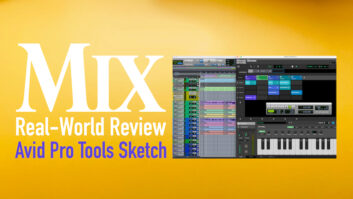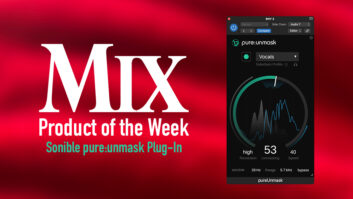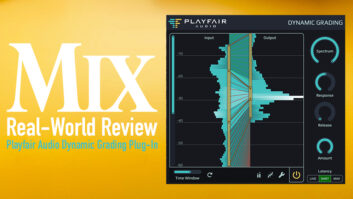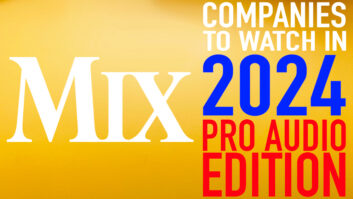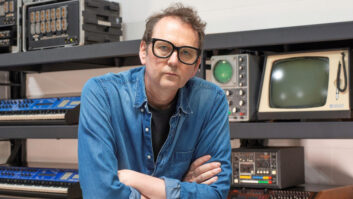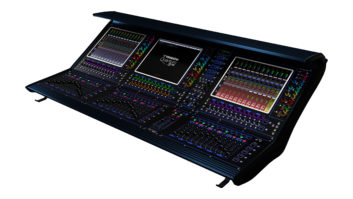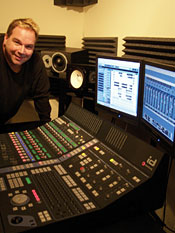
Audio engineers are one demanding group. As workstations become more sophisticated, our requirements for control surfaces have grown. When early systems offered low track/channel counts, we were okay with onscreen, GUI-based mixing and simple EQ/dynamics sections. Then, as the native power of PCs and Macs exploded, and third-party plug-ins became the order of the day, mice and video display units gave way to fader trays bedecked with linear and rotary controls. MIDI provided external control of multifunction DAWs from a conventional-looking mixing surface (and is still featured in many of today’s solutions). MIDI Machine Control (MMC) was available to map transport buttons and jog wheels from hardware to software functions.
But we soon reached a crossroads. Only so much data can be extracted from a controller, parsed and overlaid onto a transport layer for passage to the DAW engine. On top of that, data needs to be passed back to the surface to show that the function has been activated and move controls to follow automation data. What we needed was enhanced bandwidth and protocols that could accommodate these complex needs.
A breakthrough occurred in late 1996 when Digidesign and Mackie co-developed, respectively, the HUI (Human User Interface) protocol and controller, which uses multiple MIDI-type connections to carry commands between hardware controllers and Pro Tools. Using a series of standardized instructions for fader and knob positions, plus switch/button closures, the HUI protocol enabled more precise control of Pro Tools mixing, routing, editing and DSP functions. Plug-in command was also accommodated via a four-parameter section and page tables that switched control to different functions using button row/column maps of menu commands, pull-downs and window-opening sequences. Unlike 7-bit MIDI commands, which only provide 128-step resolution, HUI is based on 10-bit/1,024 discrete values using a slick MIDI controller implementation; it also operates at high bandwidth via USB and, most recently, FireWire ports.
The HUI MIDI Mapping Protocol was offered to any firm that wanted to implement it — and is still used today by many hardware manufacturers — to control Pro Tools and other DAWs that can be set to follow such commands. HUI supports a spectrum of parameters, ranging from fader level and touch-sense to pan, aux send and solo controls, plus plug-in selection and adjustment; the protocol also supports a maximum of 12-segment audio level metering and four-character track designations. One drawback of HUI is that it requires a dedicated MIDI In/Out connection per eight channels of control. As total bandwidth is shared between all ports, slowdown is inevitable.
One of the most interesting implementations of HUI control is the Solid State Logic AWS 900 Analogue Workstation System, which combines a 24-channel analog front end and mixing section with flexible monitoring and a Pro Tools or DAW command area. The preamp, EQ and dynamics sections come into their own during basic recording and overdubs, while the servo faders will control either DAW mix levels or, if you prefer to remix in the analog domain, fixed-level bus outputs. For the latter mode, SSL now offers a new AWSomation automation system based on its G/K Series Ultimation. (Interestingly, the company also offers HUI-based control from its high-end C200 digital production console.)
Harrison’s recently released IKISdirect enables HUI control over Ethernet via its IKIS console automation platform, which was designed to implement new console control surfaces and automate control of other workstations. A custom software module runs on the host CPU, extending IKIS’ database to the host and synchronizing the appropriate channels in a Pro Tools session, for example. The firm also offers direct control of Merging Technologies’ Pyramix via the latter’s newly developed Oasis protocol over the same Ethernet network as IKIS-driven worksurfaces; Steinberg Nuendo will interface in a similar fashion.
Meanwhile, Mackie and Emagic co-developed a dedicated protocol for Logic workstations (now owned by Apple). Logic Control migrated into Mackie Control Universal, with the company electing to offer hardware controllers that, with the addition of removable Lexan overlays to relabel on-surface control, would successfully work with a wide range of DAWs, including Apple Final Cut Pro and Soundtrack Pro, Steinberg Cubase and Nuendo, Cakewalk SONAR, MOTU Digital Performer, Sony Vegas and others. Extras included a two-line backlit LCD to show parameters such as track name, I/O routing, plug-ins, EQ and dynamics setting, among other features.
Mackie Control and HUI were among the first widely supported, comprehensive protocols and have become more or less de facto common standards — enabling DAW and controller manufacturers to support one another without continually re-inventing the wheel. However, some of the more innovative workstation manufacturers also offer SDKs (software developer toolkits) that allow control surface developers to more comprehensively support a DAW than what might be possible via an open-architecture protocol.
For example, Cakewalk offers a control surface SDK for its SONAR 4 workstation that allows third-party developers to design custom control surface modules. SONAR ships with a Cakewalk generic surface that can be programmed to work with any MIDI-based controller, and includes presets for control surfaces such as the JLCooper FaderMaster, Kenton Control Freak, Peavey PC1600 and Yamaha PhatBoy. Tascam US-428, CM Labs MotorMix, Mackie Control Universal, Cakewalk/Peavey StudioMix and Radikal Technologies SAC-2K also are supported, together with Tascam FW-1884, FW-1082 and DM-24; Frontier Designs TranzPort; Roland SI-24; and others.
Tascam joined the fray with a series of affordable HUI- and Mackie Control — based worksurfaces connected via USB and/or FireWire ports. However, the firm quickly spotted that DAW plug-ins that are reliant on unique GUIs seldom share a common set of parameters, and that there are wide variations in the way workstations support Mackie Control and HUI.
Tascam advises that the Mackie Control protocol is also a variable feast; the more popular DAWs will probably perform as designated by an overlay, but full consistency might not be achieved by other applications. This theory could explain why Tascam’s FW Series controllers feature three implementations of Mackie Control: a generic version, a version for Cubase SX/Nuendo and one for Cubase LE. Similarly, the Tascam US-2400 controller ships with four variations for Steinberg, SONAR, Digital Performer and Logic Series DAWs.
Digidesign developed an Ethernet-based control protocol for Pro Tools; ProControl unlocked more horsepower by using a wider and faster communication layer between the application and worksurface. The result was increased simultaneous channels, enhanced metering options and reduced latency. The networkable surface could also be extended to 48 channels, two joysticks and meters. A second Ethernet-based controller, Control|24, was co-developed with Focusrite and added analog preamps, a sub-mixer and a comprehensive monitor section.
The DigiNET protocol developed for ProControl and Control|24 was expanded to support the new ICON Integrated Console by offering more bandwidth and flexibility. By using extra packet space in the Ethernet world, more controls can be addressed simultaneously, allowing each channel strip to independently operate with sample-accurate metering. The expanded protocol also allows a worksurface to access any Pro Tools edit command or menu item. A major breakthrough for the ICON was the ability to access more than one plug-in at a time; with D-Control, users can modify under automation one plug-in per channel. (D-Command has fewer controls and, therefore, cannot address plug-ins on a channel-by-channel basis.)
In hardware terms, ICON also set a benchmark for control surface evolution. Custom faders allow users to separate the surface from the on-screen GUI and operate directly with the Pro Tools Mix Engine. It is now possible to work with hidden tracks and freely assign them across the surface as required — independently of screen settings.
As DAW engines started offering even more processing power, the size of multichannel editors and virtual mixers accessible in software became even more sophisticated. And on the other side of the street, digital console manufacturers were realizing that, for added flexibility, it makes more sense to control their proprietary DSP engines from expandable surfaces by using networkable protocols. In this way, multiple worksurfaces could be linked to not only their respective hardware-focused engine, but also third-party DAW engines. Talk about fully integrated workflow!
NETWORK-SAVVY CONTROL PROTOCOLS
There are now at least three well-documented, network-savvy protocols. Euphonix developed EuCon as a networkable, open-control protocol for System 5 consoles; the new System 5-MC combines the familiar S5 channel strips with the MC as a control interface for any EuCon-compliant workstation such as Steinberg Nuendo 3.1 and Merging Technologies Pyramix (via the latter’s Oasis protocol), plus others (via HUI-format commands over an Ethernet transport layer).
EuCon is markedly different from HUI: It allows intelligent control of all workstation functions and enables high-resolution metering, EQ and pan displays, intelligent mapping of plug-ins and assigning DAW tracks anywhere on the surface. The company’s dedicated MC controller, which can be used stand-alone, handles multiple Ethernet-hosting of workstation PCs or Mac computers, each running an MC driver. Its control surface provides DAW interrogation and command-level metering, as well as manages control of S5 channel strips.
Down under, Fairlight has been promoting the use of its RAPID (Remote Application Programming Interface for DREAM) protocol for a couple of years to control its QDC engines from Constellation Series worksurfaces and to attract interest from DAW manufacturers. However, Constellation already ships with a feature-rich audio editor, which now accommodates third-party VST plug-ins and is HUI- and Mackie Control Universal — compliant.
Merging Technologies has quietly made friends with a number of controller developers. Aside from Harrison, whose high-end digital consoles are now Oasis-compliant, Smart AV recently shipped the first three of its Elite Series controllers with networkable Pyramix mix engines. Not to be outdone, Merging Technologies has developed the ISIS Series of Oasis-based controllers for Pyramix and VCube video player/recorders.
UK-based AMS Neve offers control of Pro Tools and other DAWs from its Encore Plus automation using HUI protocol, in addition to networked control via Ethernet/TCP/IP of Pyramix via Oasis. Interestingly, Encore Plus now allows Pro Tools 5 session mix data to be imported into its DFC Gemini, MMC, Libra Post and other digital consoles; Pyramix import is also in the works. The advantage? Fader moves created within the native DAW can be imported as Encore Plus data, thereby allowing the DAW outputs to be set to unity gain during a final mix. Pundits claim that some workstation mix engines compromise headroom and noise performance during such exercises.
In addition to accommodating HUI and Mackie Control commands — and directly supporting a number of hardware controllers — Steinberg’s remote-control SDK is being used by such controller manufacturers as Mackie, Yamaha, JLCooper and Smart AV to control Nuendo and Cubase Series DAWs. The company also implemented EuCon protocol to interface Nuendo with Euphonix controllers, and worked jointly with German manufacturer WK Audio to develop the ID Controller. The latter uses a closed-architecture protocol running on USB ports that is hard-coded for Nuendo 3 (using a specialized driver that dramatically outperforms common SDKs) and is not intended for any DAW.
Smart AV has kicked into play the new Elite Series controller with sales to a leading post/film facility that will use Pyramix via Oasis as the mix engine; also newly available is an SDK for other DAW manufacturers. Workstations supported or soon-to-be-supported by the network-ready controller include Logic 7 Pro/Express and Nuendo. SADiE and MOTU’s Digital Performer are expected to follow once the SDK becomes available. The surface can also be used with various general DSP engines from Klotz, Peavey and Yamaha. Interestingly, the protocol used between the console surface and the console processor is proprietary User Datagram Protocol (UDP), which is faster and more efficient for such tasks. The protocol between the console processor and the Mac running a host Logic DAW, for example, is MIDI over UDP Ethernet (in reality, the Native MIDI-based protocol used by Apple). According to Smart AV, the latter is more comprehensive than either Mackie Control or HUI protocols; the return path from Logic to the Elite Controller is direct UDP using Apple Logic’s control surface plug-in.
In addition to supporting Mackie Control protocol for Logic Series workstations, Soundtrack Pro and Final Cut Pro, Apple compatibility with a wide cross-section of hardware controllers must be an obvious goal. (I wouldn’t be surprised if the company offers its own range of worksurfaces custom-developed for its integrated audio and video applications.) M-Audio recently introduced iControl, a portable USB-capable control surface for GarageBand 2, which Apple hopes will become a third-party developer community. The surface uses a proprietary Apple-developed protocol. (An application-specific SDK is said to be in the works.)
Yamaha, through its recent purchase of Steinberg, has a unique opportunity to develop controller products. In the past, the firm has offered MIDI-based control of basic DAWs from its digital mixers, expanding these capabilities to HUI, Mackie Control and Nuendo from DM2000, DM1000, 02R96 and 01V96 consoles. And the DME Series processing engines are controllable via HUI and Mackie Control; the company is closely examining EuCon, Oasis and RAPID, and is considering control from Smart AV Elite controllers. An initiative with Steinberg also holds great promise: Studio Connections is described as a closer integration between software and hardware that eliminates setup/recall problems. A series of SDKs for digital consoles and Nuendo/Cubase DAWs is planned.
Looking across such a varied landscape, one can identify some immediate developments. Plain-vanilla digital consoles are a thing of the past; workstations offer more bang for the buck and enable an entire project including source media to be held within one location and recovered with complete confidence at any time in the future. It’s all a matter of workflow and enhanced efficiency. The next hurdle will be to fully integrate audio with video on the same platform; a growing number of videographers and audio professionals are looking to handle picture and sound editing from the same surface, with access to new and fully connected tools.
In other words, the future is not a matter of software vs. hardware, but integrating each aspect in a seamless workflow environment. As we move toward open architecture protocols, the next big debate is sure to be over proprietary vs. nonproprietary solutions. Either way, we will all eventually be playing in the same sand box.
My sincere thanks to Gannon Kashiwa, Digidesign market manager, professional products; James “Woody” Woodburn, senior recording product manager at Mackie; and Jim Bailey, Tascam’s U.S. product manager for providing extensive background for this article and enviable patience with my probing questions. Also: Athan Billias, Yamaha’s director of marketing, technology products; Euphonix’s Martin Kloiber, CTO, and Andrew Wild, VP of marketing; Niall Feldman, SSL’s director of marketing; Matthias Korfhage, WK Audio’s management director; David Ives, Harrison by GLW’s engineering manager; Simon Daniels, AMS Neve’s product marketing manager; Lars Baumann, Steinberg’s senior product manager/Nuendo; Apple Corporation’s Christine Wilhelmy; and Cakewalk’s Steve Thomas.
Mel Lambert has been intimately involved with the production and broadcast industries for more years than he cares to remember.
Simplified Control
- Who: Rick Reynolds
- What: WK Audio ID Controller with Steinberg Nuendo
- Where: Venue Companies, Navarre, Fla.
Venue Companies provides audio services for telecommunication clients — music on-hold and voice messaging — and record production. In April, the facility added a WK ID Controller for Steinberg Nuendo 3. “The combination has a very shallow learning curve,” owner Rick Reynolds confides. “For our first project, Sounding Rick’s Unstoppable, produced by Kasim Sulton — who in the past has played bass with Todd Rundgren and Meat Loaf — we mixed 13 songs in a remarkably short period of time. Because Kasim was on his way to Europe to act as Meat Loaf’s musical director, we only had three-and-a-half days to mix an entire album.
“Thanks to the ID Controller’s intuitive design, Kasim, my engineer Paul Williams and I quickly learned our way around the worksurface. Particularly helpful was the dedicated jog wheel, which provided lightning-fast access to edit functions.
“Kasim was very pleased with the ability to use the mix controller to dial in Nuendo EQ and plug-in settings. Automation was a breeze with the ID; imagine being able to automate several faders at once during one pass. On some mixes, we had two sets of hands automating faders, mutes, pans and even VST plug-ins. That would have been impossible with a mouse!
“Since many of the tracks were recorded over a period of 10 months, there were parts/ideas that had been forgotten. With some songs having 53 tracks — including 16 tracks of guitar — you could say this was a complicated project. By using the Group function, we were able to immediately locate any track within two moves. This was a real time-saver.”

Fast Control
- Who: Tal Herzberg
- What: SSL AWS 900 Analogue Workstation System
- Where: Studio H, Henson Recording Studios, Los Angeles
A recent partnership between four-time Grammy-nominated engineer/producer Tal Herzberg and Henson Recording Studios resulted in Herzberg’s new AWS 900 forming the centerpiece of the newly refurbished Studio H, which has recently been used by the Rolling Stones, Mariah Carey and Chingy.
“The AWS 900 is the ultimate small-scale mixer,” Herzberg says. “I like the look and feel of a conventional worksurface. This board sounds, looks, feels and functions like an SSL and has a great build quality. It may not be K Series, but it’s pretty damn close; I call the AWS 900 a ‘baby K.’
“My budget [$90k] gave me the option of choosing between the AWS 900 and a 32 — fader Digidesign ICON control surface,” Herzberg continues. “I spent a few sessions on each board and finally decided to go for the SSL. My main reasons had to do with the need for 24 high-quality preamps and equalizers in the studio [which are found in the AWS 900 and not in an ICON], as well as the fact that I still prefer analog summing.
“The Total Recall and new AWSomation automation package are way cool and extremely useful. I love mixing on the AWS 900 — using the channel faders to control both Pro Tools’ mixing functions [virtual mixer] and to handle 24 analog playback outputs from Pro Tools’ audio interfaces. But for me, the standout feature is the fast access to Pro Tools plug-ins from the AWS 900 via the screen and control surface. That unique combination of assignable knobs and faders on the convention GUI is very powerful.”
Flexible Control
- Who: Nathaniel Kunkel
- What: Digidesign ICON Integrated Console
- Where: Studio Without Walls, Los Angeles
“I first saw ICON at the Berlin AES Convention [May 2004] and knew straight-away it was exactly what I needed,” says Emmy-winning producer/engineer Nathaniel Kunkel about outfitting his transportable project facility. “I purchased the 150th ICON from Digidesign and have been using it for nine months. It was the least-expensive way to get to where I wanted to be.

“Previously, I was using a [Sony] DMX-R100 digital console to track to and mix from my Pro Tools|HD2 system, but I wanted more channels. I opted for a 16-fader ICON and a center section, which, with re-assignment, would be perfect for my needs in a transportable package.
“I also wanted to access all my plug-in settings from hardware and not a GUI. With ICON, that became a reality. I had used a [Digidesign] ProControl, but, to be honest, I just didn’t get it! It was okay for vocal rides, but not much else; [for me,] it just got in the way. But with ICON, the control surface is so well-laid-out that I instantly got it. I never imagined that I could buy a system that would increase my workflow as much as ICON has, and the new automation upgrades really make it a musical mixing surface.”
The rig was recently used to mix Morrissey Live From Earls Court in stereo and 5.1, B.B. King’s latest release and a Sting DVD soundtrack in stereo and 5.1.

Post Control
- Who: Roger Savage
- What: Three Smart AV Elite Series Controllers with Merging Technologies Pyramix
- Where: Soundfirm dubbing and post stages
Soundfirm, Australia’s largest post-production facility, recently ordered the first trio of DAW controllers to be shipped by Smart AV Consoles; the Pyramix-based systems will be installed at facilities in Melbourne, Sydney and Beijing.
“We took delivery of an E48 48-channel console in early August,” says Roger Savage, Soundfirm’s owner/CEO. “An E72 and an E96 system will be added later this year,” adds the two-time BAFTA winner and Oscar-nominated re-recording engineer. “I was impressed by the controller’s ARC technology, which will make sorting out editorial tracks a whole lot easier.
“Here in Australia, our dub stages are normally single-operator, which means that there’s lots of functions to be taken care of during a busy mix. Smart AV’s ergonomic strength really comes into focus when you’re trying to manage a multitude of tracks; it is very easy to locate the controls you are after without accessing multiple layers.
“Currently, most of our film and post projects are edited in Pro Tools, so we will run those as playback sources and use the console’s Pyramix Version 5 DAW as the master recorder.
“The Smart AV Elite is a very powerful control surface. It might look like the deck of the Star Ship Enterprise, but it gets the job done. The routing control and monitor section are pretty powerful, but its usefulness depends on the DAW it connects to; after all, a Ferrari body with a VW engine is a useless combination. But Smart AV with Pyramix is going to be formidable. This technology will revolutionize the future of mixing.”

Dubbing Control
Who: John Ross
What: Euphonix System 5-MC with Steinberg Nuendo
Where: personal post facility, Los Angeles
The centerpiece of a new personal-use post/film facility currently being completed by John Ross will be a dub stage equipped with a dual-operator Euphonix System 5-MC digital console. “The effects section will feature 48 on-surface faders,” Ross explains, “while the music/dialog section will feature 32 faders. The two sections will run independently with separate MC Controllers. All mixing and processing will be handed by multiple Nuendo DAW engines.
“The System 5-MC offers all of the advantages of a well-designed control surface, with the power and flexibility of Nuendo workstations. Now I can use the power of Euphonix’s control system, whose fader movements are translated inside the box into workstation moves and stored with the session. But being event-based, all of these moves will follow Nuendo sound elements during editing and reconforming. It’s the best of both worlds.
“Important to me is the ability to not have to pay attention to the DAW screen, and for the console to behave in a way that is typical of a powerful state-of-the-art mixing console while retaining all of the benefits associated with DAW systems. I will be using three Pro Tools|HDs for additional playback — simply because it’s still the format many sound editors know — but will use Nuendo for all other functions. The Euphonix MC is the Rolls Royce of controllers. It is extremely powerful, built with the quality typical of high-end audio equipment and does not have the ‘Fisher Price, my first mixer’ feel often found in this market.”
The newly completed facility will be used in December to dub Antonio Banderas’ new movie.
